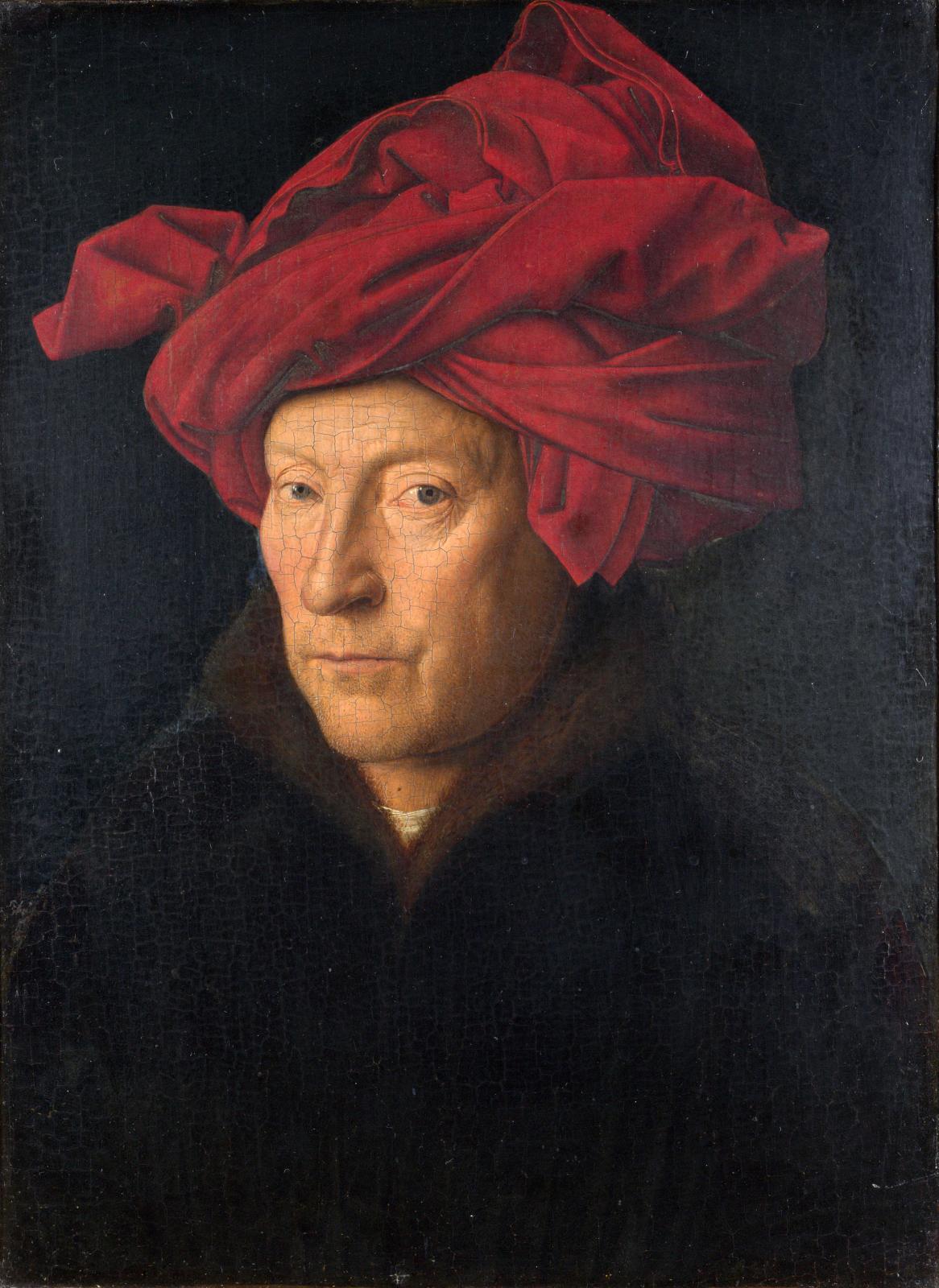He is unknown. No name, no profession, no identifying details, but he looks out with the calm sternness of one who knows his place in the world. And because of this calmness, this sternness—the skeptical gaze and tight lips—we suspect it might be an image of the artist himself. Self-portraits of artists often present them with a certain forthrightness, which is necessary because the status of artists is always uncertain—this was true in the 15th century, and it is true now. And so, in their portraits of themselves, artists show confidence, worldliness, and a measure of pride in being artists.
Worldliness: the artist is Jan van Eyck, the portrait was painted in 1433 in Bruges, and it is as much a portrait of a man as it is a portrait of his enormous red turban. Each wrinkle of the cloth, each fold, each soft glimmer of light across the soft weave, is painted with the holy precision Jan van Eyck helped introduce to art. He had abandoned tempera and begun to dissolve his pigments in linseed oil in the 1420s. With that came control and a perfection in painterly mimesis never since matched. An inscription on the frame reads, in pseudo-Greek letters, ALC.IXH.XAN—“as I can,” or “to the best of my ability.” He must have known that his best was the best. The gray-eyed gaze of the man in the painting is a dare. Show me who’s done it better, he seems to say. Didn’t think so, he adds.
***
I was in Brussels a few weeks ago. At the end of my brief visit, something happened that reminded me, in an oblique way, of the fearlessness of “Man in a Turban.” It was a Thursday, and I had a free evening. My friend F. invited me to join her at the opening of a hip place in a central part of town. Around ten, she sent a text message: “I will be a bit later, feels like a scene from your book; there are riots in Molenbeek, the part of Brussels where I live.”
She eventually arrived, and as we got our beers at the sleek new bar, in which I was the only non-white customer, F. told me about Molenbeek. It is an immigrant neighborhood, mostly Muslim, mostly poor. F., as pale as the women in paintings by Van Eyck and Memling, and her husband, who is also Flemish, chose to raise their family among Moroccan neighbors. There are African blacks in the area too. There are sometimes tensions between the two groups.
But this is what had led to the riots there that night: earlier that day, a young woman in a niqab had been stopped by police in a nearby neighborhood called Jette. The niqab is illegal in Belgium (as it is in France): adult Muslim women may not, of their own free will, cover their faces in public. In the words of the liberal MP who proposed the ban in Belgium: “Wearing the burqa in public is not compatible with an open, liberal, tolerant society."
Usually, the law is applied this way: there is a quick check of the ID and a lifting of the face veil long enough to identify the wearer. There is a caution, or a fine. But in this case, the police insisted that the woman remove the veil completely before she could be let go. She refused. She was arrested, taken to a police station, stripped (her clothing, down to the underwear, removed with scissors), and beaten by male and female officers. She fought back, headbutting one of the officers. She was beaten further, by the agents of the open, liberal, tolerant society. The woman got a concussion, and was taken to hospital.
The news got to Molenbeek. Molenbeek rioted.
***
“Man in a Turban” hangs at the National Gallery in London, next to the better known “Arnolfini Portrait,” also by Van Eyck. It is surprisingly small. Each time I see it, I have to remind myself that no, it hasn’t shrunk, it has always been just about 10 inches high. Smaller than life-size, encased in a gilt frame, quietly luminous, peculiarly forceful, larger than life.
What the man wears is not, in fact, a turban. It is a chaperon, a traditional Flemish length of cloth usually worn differently from how it is depicted here (I know of no other chaperons of the period depicted in such an explicitly turban style). Van Eyck painted for lords, princes, and the church, a career made possible by the wealth and patronage of Bruges, Ghent, Antwerp and Brussels, the great Flemish towns. The wealth of those towns was, in turn, made possible by the influx of money, trade, and taste, by Italian bankers, Burgundian and Bavarian aristocracy, merchants, visitors, and rivals of English, Jewish, Spanish, and Ottoman origin. This was the world some twenty years before the Ottoman conquest of Byzantine Constantinople. It was a cosmopolitan, complicated world. This was Flanders just before “Turk” became equated with “Muslim” and “Muslim” became equated with “menace,” launching a wave of anti-Islamic hysteria that would last well into the next century. In that earlier, more open, milieu, a cosmopolitan painter might well choose to wear his chaperon like a turban. It is no great shame for an artist to be taken for a man of the wider world. And what, precisely, is a length of chaperon worn like a turban, and influenced by turban-wearing style? A turban.
